Real Estate Development
- Digital Transformation
- Sep 15
- 3 min read


Real estate development plays a vital role in shaping the communities where we live, work, and play. From new residential neighborhoods to commercial complexes and industrial parks, the process of turning land or old buildings into valuable, functional spaces fuels economic growth and meets society’s evolving needs. In 2025, as urban populations grow and sustainability becomes paramount, understanding real estate development is more important than ever. This article explores what real estate development entails, its stages, and why it matters today.
What Is Real Estate Development?
Real estate development is the process of enhancing land or buildings to create marketable property for residential, commercial, or industrial use. Unlike simple construction, development involves a complex orchestration of planning, financing, design, construction, and marketing to transform ideas into tangible assets. Developers take risks and manage multiple disciplines—from legal approvals and architectural design to securing funding and selling or leasing the finished product.
Think of real estate development like producing a film: starting with an idea (concept), securing resources (financing), assembling a team (architects, engineers, contractors), creating the product (construction), and finally distributing it to an audience (selling or leasing).
The Stages of Real Estate Development
1. Idea Inception and Refinement
It begins with identifying an opportunity. Developers look for emerging market needs—whether new housing demand, office space, or retail outlets—and evaluate potential sites. Quick feasibility checks assess whether a project could be viable.
Once an idea shows promise, developers conduct more detailed site analysis, talk to stakeholders such as potential tenants or investors, and create tentative designs.
2. Feasibility Studies and Planning
A formal feasibility study considers market absorption rates, construction costs, regulatory hurdles, and projected revenues. This critical step ensures that the project makes financial sense and complies with zoning laws and environmental regulations.
Simultaneously, developers engage architects and planners to create detailed designs, factoring in sustainability, community impact, and usability.
3. Securing Financing and Approvals
Developers then seek financing from banks, investors, or government programs. Simultaneously, they submit plans for approvals and permits from local authorities. This phase is often lengthy and involves negotiation to meet all legal and community standards.
4. Construction Management
With approvals and financing in place, construction begins. Developers oversee schedules, budgets, and quality control, coordinating contractors and suppliers. They also start marketing efforts to attract tenants or buyers, sometimes negotiating pre-leases to secure income post-completion.
5. Completion, Leasing, and Asset Management
Upon completion, formal occupancy permits are obtained, and tenants move in or buyers close deals. Developers may continue managing the property or sell it. Asset management focuses on maintaining the property, handling leases, and maximizing long-term value.
Why Real Estate Development Matters in 2025
Meeting Growing Urban Demand
By 2050, urban dwellers are expected to comprise nearly 70% of the global population, intensifying the need for thoughtfully planned developments that address housing shortages and commercial space needs.
Economic Growth and Job Creation
Real estate development fuels local economies—it stimulates construction jobs, brings new businesses, and increases tax revenues. Well-planned developments can revitalise neighborhoods and improve residents’ quality of life.
Emphasizing Sustainability and Innovation
Modern development increasingly prioritizes green building designs, energy efficiency, and sustainable materials amid climate change concerns. Innovations like smart buildings and mixed-use developments reflect evolving market demands for live-work-play environments.
Real-World Example: Lagos Urban Development
In Lagos, Nigeria’s commercial hub, rapid population growth has created urgent demand for affordable housing and commercial infrastructure. Developers collaborating with government entities have launched mixed-use projects incorporating residential units, retail spaces, and community amenities, using green construction techniques to reduce environmental impact. These initiatives illustrate how real estate development can balance economic opportunity and sustainability.
Conclusion: Real Estate Development as a Catalyst for Progress
Real estate development is far more than construction; it is a strategic, multidisciplinary process creating spaces that support society’s changing lifestyles and economic needs. From idea conception through long-term management, developers navigate risk, design, finance, and regulation to deliver functional, sustainable assets.
In 2025 and beyond, as urbanization and environmental challenges intensify, real estate development stands at the crossroads of opportunity and responsibility. For investors, urban planners, and communities alike, understanding this process offers insight into how tomorrow’s cities and neighborhoods will take shape.
Reflecting on these factors, real estate development not only builds structures but also builds the foundation for vibrant, resilient communities and prosperous economies.



Comments